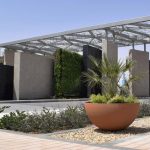Landscape design is the art of transforming outdoor spaces into captivating and functional environments. Whether you’re a homeowner looking to enhance your backyard or a property developer aiming to increase the appeal of your project, understanding the principles of landscape design can lead to breathtaking results. In this blog post, we’ll delve into the fundamentals of landscape design, providing you with valuable tips and inspiration to craft outdoor spaces that are not just beautiful but also purposeful.
- Begin with a Vision:
The first step in creating a stunning outdoor space is to envision what you want to achieve. Do you desire a tranquil garden retreat, a vibrant social hub, or a mix of both? Your vision will guide the entire design process.
Start by sketching your ideas or creating a vision board with images that resonate with your dream outdoor space. This initial brainstorming phase will set the tone for your project.
- associated with the Principles of Design:
Landscape design follows several key principles that can help you achieve harmony, balance, and functionality in your outdoor space:
Unity and Harmony: Ensure that different elements in your landscape work together cohesively, creating a unified and pleasing composition.
Balance: Strive for balance in your design, whether it’s through symmetrical arrangements or by balancing heavy and light elements.
Proportion and Scale: Consider the size and scale of your outdoor features to maintain visual harmony. Oversized elements can overwhelm a space, while undersized ones may get lost.
Rhythm and Repetition: Create visual interest by repeating certain elements like plants, colors, or patterns throughout your design.
- Choose the Right Plants:
Plants play a pivotal role in any landscape design. Selecting the right plants for your climate, soil type, and maintenance preferences is crucial. Native plants are often a wise choice as they adapt well to local conditions and require less upkeep.
Consider a mix of evergreen and seasonal plants to ensure year-round appeal. Incorporate a variety of textures, colors, and heights to add depth and interest to your garden.
- Hardscape Elements:
Incorporate hardscape elements like pathways, patios, and outdoor structures. These provide structure and functionality to your outdoor space. Choose materials that complement your overall design, such as natural stone, wood, or pavers.
- Lighting and Accessories:
Outdoor lighting can transform your space from day to night, creating a magical ambiance. Strategically placed lights can highlight architectural features or guide pathways. Don’t forget to add accessories like outdoor furniture, sculptures, or water features to complete the look.
- Maintenance and Sustainability:
While designing your outdoor space, consider its long-term maintenance. Sustainable landscaping practices can reduce water consumption and maintenance efforts. Installing a drip irrigation system or using drought-tolerant plants are eco-friendly choices.
Landscape design is a dynamic art form that allows you to shape and personalize your outdoor space. By understanding the principles of design, choosing the right plants and elements, and embracing sustainability, you can create an outdoor oasis that reflects your vision and enhances the beauty and value of your property. Whether you’re a homeowner or a property developer, the art of landscape design has the power to transform your outdoor spaces into stunning, functional environments that leave a lasting impression.







